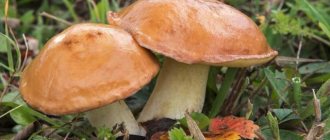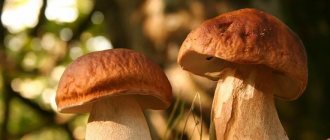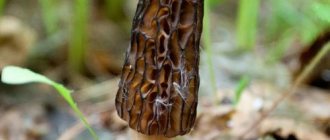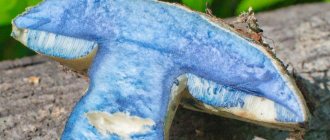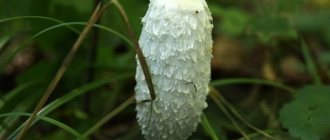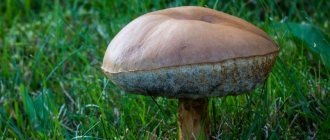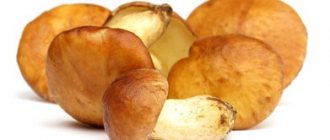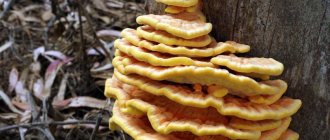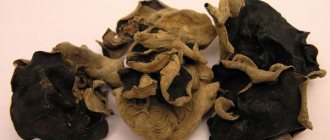05.10.2021 12:00
109
The porcini mushroom belongs to the boletus family and is sometimes called that. It is characterized by a thick, stable stem and a massive cap, the color of which depends on the age and place where it grows. It can be light, yellowish and brownish. It got its name precisely because the flesh when cut is snow-white in color and even during heat treatment retains this color.
The product is characterized by a rich taste and light aroma. Let's talk about its composition, beneficial qualities and possible harm.
What does porcini mushroom look like and where does it grow?
The porcini mushroom belongs to the Borovikov genus. It occupies a leading position in the list of the most useful mushrooms. It is difficult to confuse him with other representatives of the forest world. It got its name due to the preservation of the white color of the pulp after heat treatment. Other mushrooms turn black during cooking.
The diameter of the cap of the fruiting bodies ranges from 7 to 30 cm, depending on age. The height of the leg is 7-10 cm. It is barrel-shaped and has a white or grayish color. The color of the cap can be dark or light brown. In young specimens it has a slightly convex shape, and over time it becomes flat. In dry weather, cracks appear on the cap, and after rain it becomes covered with a slimy film. The boletus pulp is dense and juicy.
The benefits of the product are most pronounced for older people
The porcini mushroom can survive in almost any conditions, except severe drought and frosty winters. Most often it is found in coniferous-deciduous forests. The likelihood of finding it under a tree over 50 years of age is much higher. Porcini mushrooms also love mosses and lichens, but do not prefer peat bogs and swamps. Active growth occurs from June to September. Collection takes place in August or September.
How not to be confused with false mushrooms?
Boletus has inedible “doubles”. They are very similar to their edible counterpart, but contain toxic and poisonous substances in their pulp. Inexperienced mushroom pickers often confuse boletus mushrooms with false mushrooms, which leads to poisoning.
Inexperienced mushroom pickers who do not delve into the nuances of the appearance of mushrooms often confuse boletus with a false porcini mushroom. We are talking about a gall fungus, which is also popularly called mustard. It is not poisonous, but contains toxic substances that can cause poisoning.
Differences by which gall fungus can be distinguished:
- in bitterling, the flesh turns pink when cut;
- tastes bitter - one mushroom is enough to ruin a mushroom dish;
- the hat becomes sticky after rain;
- the leg is beige, widened at the bottom, with an openwork pattern;
- smells unpleasant - similar to the smell of rotten onions (young mushrooms do not smell);
- Bitter mushrooms are not eaten by animals, insects, or worms.
To quickly determine whether a mushroom is a boletus or a mustard mushroom, mushroom pickers lick the flesh with the tip of their tongue. This is not prohibited, but a risky method. You should definitely spit and rinse your mouth with water after taking a sample of bittersweet.
Another false lookalike that can be confused with the edible boletus is the satanic mushroom. It is much more dangerous than bitterling and can lead to serious poisoning. Immediate hospitalization is required after consuming this mushroom.
How to recognize a satanic mushroom:
- it has a bright red leg, which almost immediately turns blue when cut;
- Old mushrooms have an onion smell.
Chemical composition and nutritional value of porcini mushroom
Porcini mushrooms contain many nutrients. That is why it is difficult to overestimate their health benefits. In addition, the product has a fairly pleasant taste.
The composition contains the following useful components:
- amino acids;
- polysaccharides;
- vitamins of groups C, B, PP and E;
- lecithin;
- trace elements (manganese, iron, fluorine, cobalt, zinc, copper, iodine, sulfur);
- macroelements (calcium, sodium, magnesium, phosphorus, potassium);
- alimentary fiber.
What vitamins are in porcini mushrooms
The benefits of the product for the body are due to its rich vitamin composition. It contains a record riboflavin content. It is responsible for the condition of the skin, nails and hair and stabilizes the functioning of the thyroid gland. Vitamin A improves the absorption of iron and restores energy resources. Vitamin PP participates in redox reactions, thereby normalizing metabolism. Vitamin E in the product provides powerful antioxidant effects and protects the body from free radicals. Ascorbic acid, in turn, has a pronounced immunostimulating effect.
How many calories are in porcini mushrooms?
Despite their high nutritional value, boletus mushrooms can be an excellent option for dietary nutrition. They are quite filling, but do not affect the figure. The calorie content per 100 grams of porcini mushrooms is 30 kcal. If you fry the product with the addition of vegetable oil, it will increase. The energy value of porcini mushrooms in the form of BZHU is displayed in the following ratio:
- proteins – 3.7 g;
- fats – 1.7 g;
- carbohydrates – 1.1 g.
Comment! The glycemic index of the product is 15 units.
Interesting Facts
Porcini mushrooms are not only of culinary interest. Being the most valuable and tasty in the entire mushroom kingdom, boletus mushrooms are distinguished by other features.
Interesting things about porcini mushrooms:
- Contain substances that have antitumor effects. And if you eat them in dried form, about 80% of the protein is absorbed.
- In Russia, the largest specimen was found in 1964. It grows in forests in the Vladimir region. The weight of the record holder is 8 kg. And the latest mushroom was found in 1974 in the Zhitomir region (Ukraine). The date is December 29.
- “Mushroom tours” are popular among Europeans. Lovers of “silent hunting” go to Finland to search for mushrooms.
- Despite developed technologies, porcini mushrooms are still collected by hand. Growing them in greenhouse conditions is considered unprofitable. And already 10 hours after collection, boletus mushrooms lose their beneficial qualities - this negatively affects their marketability.
The porcini mushroom does not have many varieties, and it is extremely difficult to confuse it with poisonous or false mushrooms. This large and tasty mushroom has unique taste and nutritional properties, as well as bright external characteristics that make it easy to recognize it among other representatives of the mushroom kingdom.
0
0
Copy link
What are the benefits of porcini mushroom for the human body?
The presence of the product in the diet has significant health benefits. First of all, this concerns the immune system, which performs protective functions. In addition, metabolism improves and physical endurance increases. Experts especially recommend consuming boletus mushrooms for those who work in hazardous industries. They have the ability to remove harmful substances from the body. The benefits of porcini mushrooms are as follows:
- activation of brain activity;
- acceleration of recovery processes;
- normalization of the gastrointestinal tract;
- analgesic effect;
- hepatoprotective effect;
- stimulation of the production of granzymes and perforins;
- strengthening the immune system;
- help in losing weight without harming muscles;
- antiviral effect;
- antitumor effect.
To preserve the integrity of the fruiting bodies, a basket is used for collection.
Is it possible to eat porcini mushrooms while breastfeeding?
Many women are interested in the possibility of eating mushroom pulp while breastfeeding. Experts do not recommend adding it to the diet earlier than 4 months after delivery. This can cause colic and allergies in the baby. At a later age, the medicinal properties of porcini mushrooms will fully manifest themselves. But it is important to introduce the product in small portions, observing how the child reacts to it.
We recommend reading: The benefits and harms of umi budo (sea grapes)
Can pregnant women eat porcini mushrooms?
High nutritional value makes porcini mushrooms a unique product. You should not give them up during pregnancy. But it should be noted that in excessive quantities they can cause problems with stool and heaviness in the stomach. Mushrooms take a very long time to digest, making them inferior to animal protein sources. In addition, they are able to absorb toxic substances. To avoid the harmful effects of the product, the following rules must be observed:
- do not eat damaged and wormy fruit bodies;
- It is advisable to chop the product into small pieces;
- Cooking and stewing are allowed, but marinated and salted use is prohibited;
- heat treatment must be thorough;
- Before cooking, rinse boletus mushrooms thoroughly with running water.
Calorie content
| Types of porcini mushroom regarding preparation method | Kilocalorie content per 100 g of product |
| Marinated boletus | 10 – 25 kC |
| Fresh, boiled, frozen gifts of nature | 15 – 30 kC |
| Fried | Up to 165 kC |
| Dried | 230 – 290 kC |
The table eloquently shows who and in what form is best to consume the product. Those who want to “maintain their figure” should avoid fried and dried mushrooms, preferring boiled or pickled mushrooms. Fried whites and with potatoes are finger-licking, but due to the high natural ability to absorb (in this case, sunflower oil, which the dish is prepared with), the calorie content increases significantly.
The most high-calorie foods are dried mushrooms. They are also the most beneficial for the human body, as they retain almost all the necessary vitamins, macro- and microelements. Moreover, it is the dried product that has the highest content of proteins, which are best absorbed by the human body in this form - 80%. Therefore, they are strongly recommended for active bodybuilders - 500 g per day.
Dried porcini mushrooms
Fact! The proportion of BJU in 100 g of fresh product is as follows: 43% proteins, 44% fats and 13% carbohydrates.
At what age can children eat porcini mushrooms?
The rich content of nutrients in porcini mushrooms does not mean that they can be consumed uncontrollably. The digestive system of young children does not yet have the necessary enzymes to digest the product. It is permissible to introduce it into the diet only from 5 years. At the initial stages, eating dishes with a slight addition of mushrooms is encouraged. From the age of 7 you can eat pies with mushroom filling, casseroles and sauces. Eating boletus mushrooms as an independent dish is allowed only from 10 years of age.
Benefits of dried porcini mushrooms
To preserve the benefits of the product for a long time, they are dried. Such preparations will allow you to enjoy your favorite dish at any time. The amount of useful substances during the drying process decreases slightly. The characteristic aroma and rich mushroom taste are also preserved.
The benefits of dried porcini mushrooms are as follows:
- assistance in the breakdown of fats;
- antitumor effect;
- strengthening the immune system;
- analgesic effect;
- hepatoprotective effect.
Dried mushroom pulp is considered a fairly good alternative to fresh. The protein in its composition is much better absorbed by the digestive system. If a person has diseases of the gastrointestinal tract, this option is most preferable.
Important! Dried mushrooms, crushed, can be used as a seasoning.
Habitat
The porcini mushroom is an extremely common species: without exaggeration, it grows on all continents, with the exception of Australia. In North America it is found all the way to Mexico in the south, in South America it is Uruguay and Brazil.
In Europe, this species can be found in the territory from Scandinavia to Southern Italy, as well as in Turkey, the British Isles and Iceland. In Asia, these are Syria, Lebanon, Mongolia, China, Japan. In Africa, in addition to the south, the white mushroom has also become widespread in the northern part up to Morocco.
It grows everywhere in the CIS, while in some regions it is a frequent resident, while in others it is less common.
Interesting! The porcini mushroom is one of the few species that, although rare, can be found even in the Arctic zone, tundra and forest-tundra.
Prefers well-drained soils - sandy, sandy loam, loamy. Rarely found on waterlogged soils, swamps and peat bogs. At the same time, during the dry, arid period, it likes to settle in more humid places.
It grows singly or forms small families, usually consisting of 2-5 or more specimens.
Where does the porcini mushroom grow?
The porcini mushroom forms mycorrhiza (symbiosis with the roots of the plant) with about fifty deciduous and coniferous tree species, but gives preference to birch, oak, spruce and pine.
Many people, especially novice mushroom pickers, are interested in where to look for porcini mushrooms. First of all, in deciduous, coniferous and mixed forests. In forest-steppe and steppe it is much less common.
The yield of porcini mushroom is 64-260 kg/ha per season.
Information! This species can be grown at home. It is enough to purchase white mushroom mycelium (mycelium) in specialized stores.
The use of porcini mushrooms in medicine
Due to the huge number of beneficial properties, porcini mushrooms are common not only in cooking, but also in alternative medicine. Riboflavin in their composition helps to cope with diseases of the thyroid system. The complex of vitamins has a beneficial effect on the condition of nails, hair and skin. Lecithin, which is part of the product, ensures the prevention of atherosclerosis and anemia. It is able to break down cholesterol plaques formed in blood vessels.
We recommend reading: Benefits of beans, properties and contraindications
The use of porcini mushroom tincture is important for thrombophlebitis and varicose veins. It can be taken orally and used locally. Rubbing the lower extremities has a beneficial effect on blood circulation and eliminates discomfort.
Before use, it is important to thoroughly clean the fruiting bodies of dirt and debris.
For impotence and uterine fibroids, the drug is taken orally. Frequency – twice a day, 1 tbsp. l., after diluting the tincture with a small amount of warm water. For cardiovascular diseases, a single dosage is 1 tsp.
A decoction of porcini mushrooms can be used for hypertension and cholecystitis. It is taken 120 ml 1-2 times a day. In terms of nutritional value, it is in no way inferior to chicken broth. It is often used to speed up recovery processes after suffering serious illnesses.
Porcini mushrooms are also used against cancer as an addition to the main therapy. They have a general strengthening effect and remove toxic substances from the body. The desired effect is achieved due to the content of beta-glucan.
Beneficial features
“White” got its name due to the fact that, unlike all others, this mushroom does not change its color when dried, defrosted and cooked. And because of its nutritional value, taste and usefulness, it was even nicknamed the “king of mushrooms.”
Its numerous medicinal properties have also become widely known. The amount of riboflavin, an important vitamin that is necessary for normalizing thyroid function, is much greater than in other types of mushrooms.
This mushroom is also valued for its large amount of beta-glucan. This carbohydrate is a powerful antioxidant that helps strengthen the immune system and is an excellent defense against bacteria, viruses and toxic substances.
Boletus is a source of high-quality protein, which plays a huge role in stimulating the secretion of gastric juice. But the process of protein assimilation is complicated by the presence of chitin polysaccharide in the cell walls of freshly prepared mushrooms. Therefore, to obtain greater benefits, it is recommended to use dried mushrooms in food. In this case, up to 80% of proteins are absorbed.
Important! Due to the high protein content, this product is even equated to meat. But there is very little fat in mushrooms.
Excess lecithin in the composition of porcini mushroom prevents the deposition of cholesterol on the walls of blood vessels, which makes it useful for anemia, atherosclerosis, as well as liver diseases, disorders associated with the brain and spinal cord. External use of an aqueous extract from boletus helps restore skin in case of frostbite.
Even in the fight against cancer, this type of mushroom plays a significant role. After all, it contains polysaccharides and sulfur in large quantities. The extract from the boletus body has a tonic effect on the human immune system, slows down the process of tumor development, and sometimes completely stops metastasis.
But for oncology, it is not the mushrooms themselves that are useful, but their constituent components, obtained through a certain chemical treatment.
IMPORTANT! Before using mushrooms for medicinal purposes, medical advice is required. This product cannot replace the main treatment of the disease: it can only be used as a component of complex therapy.
Not only in medicine, boletus mushrooms are famous for their qualities. They are widely used in cooking in completely different forms:
- fried, stewed with onions and other vegetables with the addition of sour cream, tomato, spicy, milk and other sauces, as a side dish;
- boiled - for adding to soups, salads, pizza, casseroles, for preparing Korean snacks;
- pickled and salted - for storage, canning;
- dried - for adding to various dishes, for use in folk medicine.
How porcini mushrooms are used in cosmetology
Porcini mushroom also successfully treats cosmetic problems. It acts as an effective rejuvenating and protective agent. Even in ancient Rome, the product was used to eliminate pimples and acne. In Asian countries it was used to combat wrinkles. It is believed that homemade masks based on porcini mushrooms make the skin smooth and elastic.
For many years, the benefits and harms of porcini mushroom decoction for hair have been studied. They were rinsed with a healing drink after the washing procedure. Hair became more shiny and manageable.
Harm of porcini mushroom and contraindications
Before you diversify your diet, you need to become familiar with not only the health benefits, but also the harms of porcini mushrooms. Unpleasant symptoms can occur if the heat treatment of the product is neglected. Specimens collected near industrial facilities and highways can also cause harm. Especially if they have absorbed mercury, lead and harmful fumes for a long time. Possible adverse reactions include the following:
- stomach ache;
- urge to vomit;
- stool disorder;
- dizziness;
- allergic reaction.
Since mushrooms are a fairly heavy product, not everyone is allowed to eat them. Contraindications include:
- disruption of the gastrointestinal tract;
- individual intolerance;
- age under 5 years;
- the first months of breastfeeding.
Attention! If an allergic reaction occurs, you should take an antihistamine.
How to select and store porcini mushrooms
When self-harvesting, the fruiting bodies are cut off with a sharp knife. To determine its quality, you should lightly press on the cap. It should make a characteristic crunch. Fruit bodies should not have visible damage or traces of worms. A similar analysis must be carried out before purchasing a product in a store or market. It should smell pleasant.
Important! It is advisable to make purchases from trusted sellers.
It is advisable to eat freshly picked mushrooms on the first day. They can be stored in the refrigerator for no longer than 5 days. When frozen, they retain their benefits throughout the year. The shelf life of the dried product can be up to 18 months.
Storage
Fresh mushrooms can be stored on the bottom shelf of the refrigerator (temperature +2ºC – +4ºC) for 10 – 12 hours. In general, this is generally known information. But how to preserve the beneficial properties and taste of the delicacy longer? There are such ways:
- Freezing.
- Drying.
You can freeze fresh, boiled or fried mushrooms. Fresh - washed, peeled, cut into small pieces, packaged in portioned jars, plastic bags, frozen and stored at -18ºC. The procedure is repeated for other types of freezing, only before this the delicacy must be boiled or fried. When defrosting, the nutritional value does not actually decrease, the taste is fully preserved. The specified temperature conditions allow you to store the delicacy for 1 year. Reducing the temperature reduces shelf life.
Considering that dried mushrooms are the most beneficial for the body, this harvesting process is most in demand. You can dry them in the sun in clear windy weather, in the oven or microwave. Before this, the product needs to be prepared - cleaned, washed, preferably cut into thin plates of 5 mm thickness. Actually, the natural process involving sunlight and heat is not worth describing - everything is very clear. Readiness is determined visually or by touch. Another thing is the stove:
- the oven must be preheated to +45ºC, put parchment paper on a baking sheet, and place a batch of mushrooms ready for the procedure on top;
- when the plates stop sticking to the sheet, the temperature must be increased to +75ºC and drying continued with the oven door slightly open so that the water evaporates freely;
- the event lasts 2 days, during which the baking sheet must be periodically removed and the plates turned over.
The presence of a microwave reduces drying to 1 hour. We set it to +100ºC, load a batch of prepared whites and simmer for 20 minutes. Then open the unit door for 10 minutes to ventilate the moisture and continue drying for the remaining 30 minutes.
Creamy mushroom soup
Fact! The defining moment in drying is proper storage. The finished product is stored in fabric bags. It can be linen or cotton fabric. At worst - two layers of gauze. Glass containers are also suitable, but the jars must first be sterilized and wiped dry. The shelf life of dried boletus mushrooms is 1.5 years.
